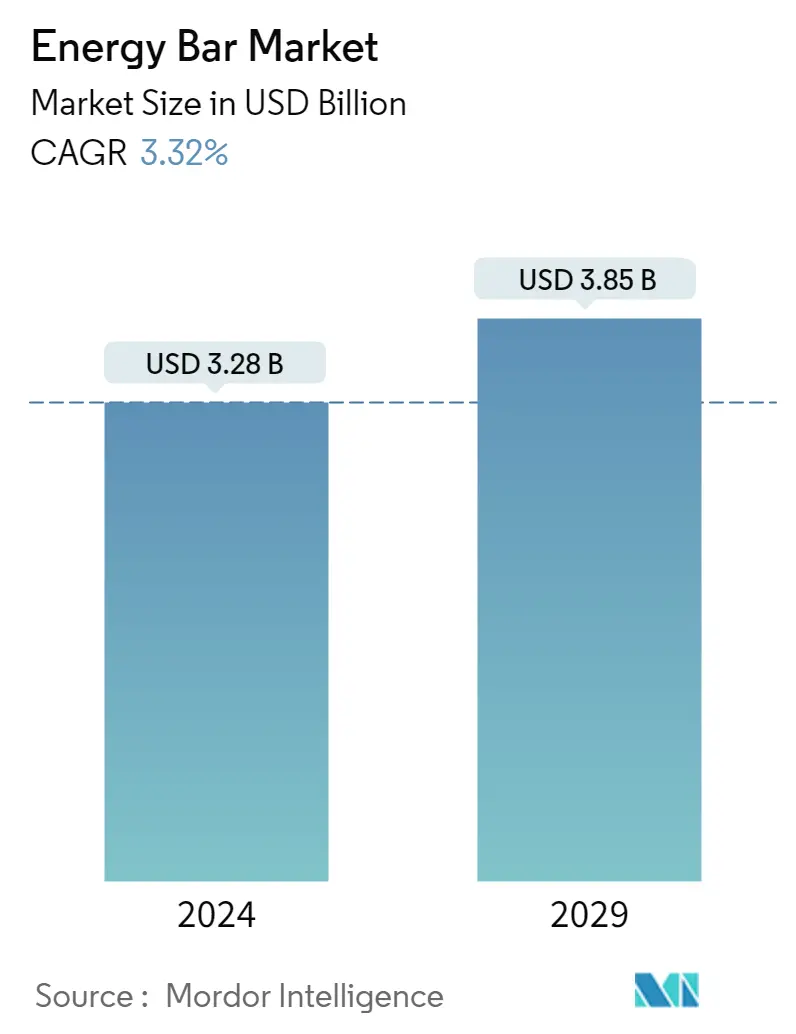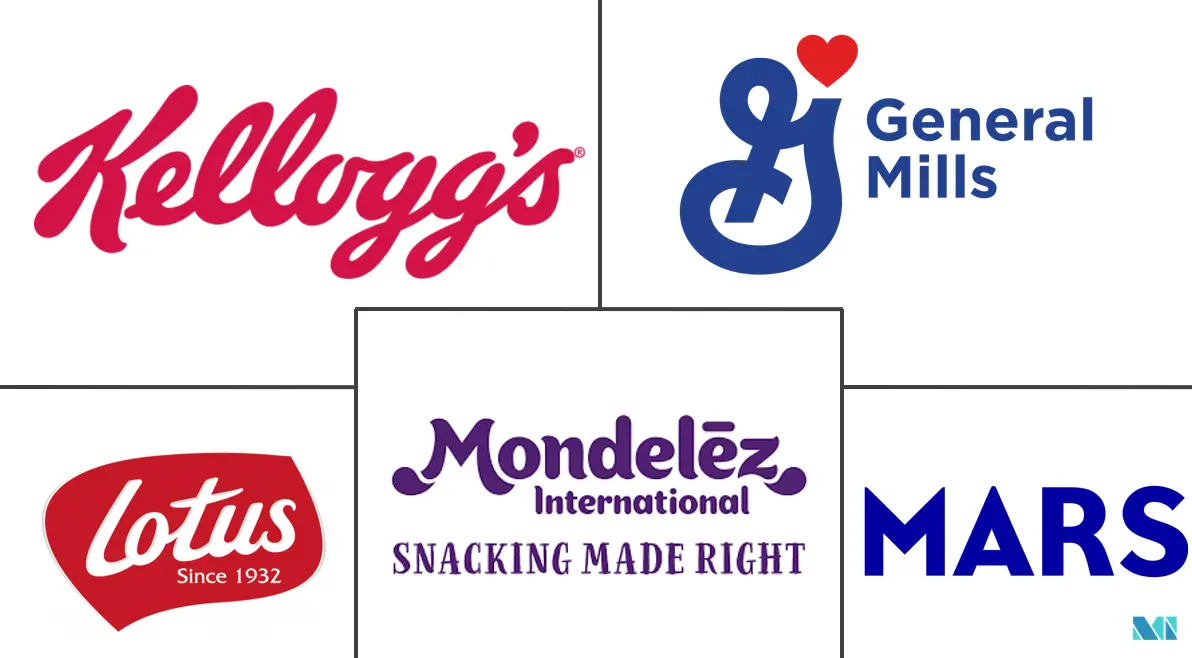Market Size of Energy Bar Industry

| Study Period | 2019 - 2029 |
| Market Size (2024) | USD 3.28 Billion |
| Market Size (2029) | USD 3.85 Billion |
| CAGR (2024 - 2029) | 3.32 % |
| Fastest Growing Market | South America |
| Largest Market | North America |
Major Players
*Disclaimer: Major Players sorted in no particular order |
Energy Bar Market Analysis
The Energy Bar Market size is estimated at USD 3.28 billion in 2024, and is expected to reach USD 3.85 billion by 2029, growing at a CAGR of 3.32% during the forecast period (2024-2029).
Sports nutrition bars have gained popularity, majorly among athletes and individuals engaging in physical activities. The rising fitness awareness and staying healthy is increasing participation in sports, health and sports clubs, and gyms, which is one of the key drivers contributing to the growth of the energy bars market. Energy bars have also found high popularity in the sports nutrition market as sports activities involve lots of energy breakdown. Energy bars are convenient and efficient for supplying instant energy to athletes. Hence, the demand for these products is gaining traction among athletes.
The consumer demand for convenient and healthy on-the-go snack options is the primary driving factor for the sales of energy bars globally. Due to their small packaging and high energy content, they are the ideal solution for adults who need instant results. They also contain proteins, other nutrients, and micronutrients as per daily requirements. Thus, they pack a balanced diet in small quantities. Furthermore, the increasing demand for energy bars for different consumers' needs led to various product innovations and increased healthy ingredients used.
Energy bars packaging also plays a crucial role in attracting customers and building companies' brand image. For example, in May 2022, Kellogg's collaborated with design firm Landor & Fitch to develop a new packaging system that complemented the brand's current offerings. The new packaging was rolled out in regions such as the United Kingdom, Ireland, Benelux, France, Italy, Portugal, Spain, the Middle East, and North Africa. Furthermore, innovating and labeling the products with popular food trends, such as gluten-free, vegan, low fat, low calories, no added sugars, and sweeteners, are further propelling the market growth by attracting various customers.
Energy Bar Industry Segmentation
An energy bar is a healthy snack with nutritional ingredients that boost energy and endurance. The energy bar market is segmented by type, distribution channel, and geography. Based on type, the market studied is segmented into organic and conventional. The market is segmented by distribution channel into supermarkets/hypermarkets, convenience stores, specialty stores, online retail stores, and other distribution channels. The report also analyzes the market studied in emerging and established regions, including North America, Europe, South America, Asia-Pacific, Middle-East, and Africa. For each segment, the market sizing and forecasts have been done based on value (in USD million).
| Type | |
| Organic | |
| Conventional |
| Distribution Channel | |
| Supermarkets/Hypermarkets | |
| Convenience Stores | |
| Specialty Stores | |
| Online Retail Stores | |
| Other Distribution Channels |
| Geography | |||||||||
| |||||||||
| |||||||||
| |||||||||
| |||||||||
|
Energy Bar Market Size Summary
The energy bar market is experiencing significant growth, driven by increasing consumer demand for convenient and healthy on-the-go snack options. This trend is particularly evident among athletes and individuals engaged in physical activities, who seek quick energy solutions to support their active lifestyles. The market is further propelled by the rising awareness of fitness and health, leading to greater participation in sports and fitness activities. Energy bars, with their compact packaging and high energy content, serve as an ideal snack for those needing instant energy and a balanced diet in a small quantity. The market is also witnessing product innovations and the incorporation of healthy ingredients to cater to diverse consumer needs, enhancing the appeal of energy bars.
In North America, the demand for energy bars is fueled by the fast-paced lifestyles of consumers, who increasingly prioritize convenience foods. The region's focus on health and wellness trends, along with the popularity of snack bars with various health claims, is driving market growth. Major players in the energy bar market, such as Kellogg's, General Mills Inc., and Mondelēz International, are investing in product innovation and geographic expansions to strengthen their market presence. The acquisition of Clif Bar & Company by Mondelēz International is a notable example of strategic moves aimed at enhancing their global snack bar business. As consumers continue to seek convenient and nutritious food options, the energy bar market is poised for further expansion.
Energy Bar Market Size - Table of Contents
-
1. MARKET DYNAMICS
-
1.1 Market Drivers
-
1.2 Market Restraints
-
1.3 Porter's Five Forces Analysis
-
1.3.1 Bargaining Power of Suppliers
-
1.3.2 Bargaining Power of Buyers/Consumers
-
1.3.3 Threat of New Entrants
-
1.3.4 Threat of Substitute Products
-
1.3.5 Intensity of Competitive Rivalry
-
-
-
2. MARKET SEGMENTATION
-
2.1 Type
-
2.1.1 Organic
-
2.1.2 Conventional
-
-
2.2 Distribution Channel
-
2.2.1 Supermarkets/Hypermarkets
-
2.2.2 Convenience Stores
-
2.2.3 Specialty Stores
-
2.2.4 Online Retail Stores
-
2.2.5 Other Distribution Channels
-
-
2.3 Geography
-
2.3.1 North America
-
2.3.1.1 United States
-
2.3.1.2 Canada
-
2.3.1.3 Mexico
-
2.3.1.4 Rest of North America
-
-
2.3.2 Europe
-
2.3.2.1 United Kingdom
-
2.3.2.2 Germany
-
2.3.2.3 Spain
-
2.3.2.4 France
-
2.3.2.5 Italy
-
2.3.2.6 Russia
-
2.3.2.7 Rest of Europe
-
-
2.3.3 Asia-Pacific
-
2.3.3.1 China
-
2.3.3.2 Japan
-
2.3.3.3 India
-
2.3.3.4 Australia
-
2.3.3.5 Rest of Asia-Pacific
-
-
2.3.4 South America
-
2.3.4.1 Brazil
-
2.3.4.2 Argentina
-
2.3.4.3 Rest of South America
-
-
2.3.5 Middle-East and Africa
-
2.3.5.1 Saudi Arabia
-
2.3.5.2 South Africa
-
2.3.5.3 Rest Middle-East and Africa
-
-
-
Energy Bar Market Size FAQs
How big is the Energy Bar Market?
The Energy Bar Market size is expected to reach USD 3.28 billion in 2024 and grow at a CAGR of 3.32% to reach USD 3.85 billion by 2029.
What is the current Energy Bar Market size?
In 2024, the Energy Bar Market size is expected to reach USD 3.28 billion.

